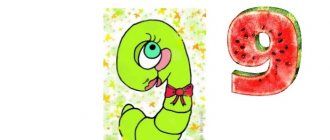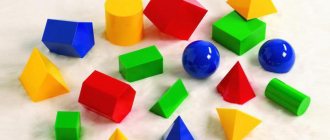"Introduction to the number and number 3"
PERSONAL:1. Show interest in mathematics.
2. Master the role of a student based on following the rules of behavior in the lesson and interaction with the teacher and classmates.
3. Show interest in acquiring and expanding knowledge.
4. Master mathematical language.
METAPUBJECT:
- Regulatory:
understand and apply the methods proposed by the teacher for solving a learning task;
adopt an action plan for solving simple learning problems and follow it;
carry out educational activities in a practical and mental form under the guidance of a teacher;
carry out step-by-step control of your actions under the guidance of the teacher.
- educational:
navigate the textbook material and find the necessary information according to the teacher’s instructions;
compare objects in order to highlight their various characteristics;
determine the pattern of objects and use it to complete the task;
choose the basis for classifying objects and carry out their classification (dividing objects into groups) according to a given or established criterion;
carry out synthesis as composing a whole from parts;
build simple chains of logical reasoning;
find and read information presented in different ways.
- communicative:
take part in work in pairs and in a group with classmates: determine common goals of the work, outline ways to achieve them, distribute roles in joint activities, analyze the progress and results of the work done;
ask and answer questions;
apply mathematical knowledge and mathematical terminology when expressing your opinions and proposed courses of action;
exercise mutual control.
SUBJECT:
1) related to updating:
a) compare different objects;
b) count various objects (objects, groups of objects, sounds, movements, syllables, words, etc.) and establish the serial number of a particular object in the specified counting order.
2) related to learning new things:
a) count various objects (objects, groups of objects, sounds, movements, syllables, words, etc.) and establish the serial number of a particular object in the specified counting order;
b) explain how numbers are formed in the natural series;
c) recognize a sequence of numbers compiled according to a given rule;
d) write the number 3.
3) related to the inclusion of new material in the knowledge system:
a) count various objects (objects, groups of objects, sounds, movements, syllables, words, etc.) and establish the serial number of a particular object in the specified counting order;
b) recognize a sequence of numbers composed according to a given rule.
Abstract of the OOD “Introduction to the number 3”.
— How did you get three fungi? (One fungus was added to two mushrooms.) 2+1=3
Malvina has one goal. Children lay it out on the table. Pinocchio has two goals. One ball, two balls. Baby, can you figure out how many of them there are? (three) - How did you get three balls? (Two were added to one.) 1+2=3 - Guys, who guessed what magic number lives in this city? (Three) And here it is - look, (image) The number three appears. Three - the third of the icons - Consists of two hooks. Guys, in ancient times, people learned to count to two with great difficulty, and only after many, many years they began to advance in counting. Every time something unknown and mysterious began after the deuce. When they counted 1, 2. Then after two it was “that’s it.” Therefore, the number 3, which should have followed the number 2 when counting, meant “everything.” For a long time, the number three was a lucky, magical number for many peoples. The number three has become the most favorite number in both myths and fairy tales. — What fairy tales have the number 3 in their titles? (“Three Bears”, “Three Little Pigs”, “Three Heroes”). — Guys, answer the question: In the fairy tale “The Three Bears,” how many chairs, cups, spoons, and beds were there? And now is the time to rest. We got up. Physical education session: (performed to music)
Pinocchio stretched, Once - he bent down, Two - he bent down, He spread his arms to the sides, Apparently he couldn’t find the key.
To find the key, we need to go further. Work in a notebook
We continue our journey through the city of Magic Number.
Ahead of us is the street Number 3. We open the notebook “I count to ten.” Task No. 1.
In each rectangle, draw as many circles as there are animals in the picture. Task No. 2.
draw so many balls in each rectangle so that their number corresponds to the number below them.
Task No. 3
Circle the number 3 on the dots and write it in each cell.
Working with geometric material. —
Near the street number 3, there is a park of one of the geometric shapes.
Guess what geometric figure we are talking about. (Help on the slide) You will immediately find out who I am. Look at me, I only have three. Three sides and three corners, Three peaks - points, I like it, friends. After all, a triangle
.
-Name three triangular-shaped objects. Generalization.
—
While traveling through the Geometric Figures Park, we came to a swamp where Tortila the turtle lives.
She will give us the golden key if you answer the questions: - What date did you meet today? — What is the name of the third day of the week? — What is the name of the third month of the year? Here is the golden key, It is magical, not simple. Reflection.
Guys, because we helped Pinocchio he gives you a golden key as a souvenir of his photo, but he asks you to write in the empty window the number that we learned today. - Let's say goodbye to Pinocchio and wish him to never lose the golden key again.
Summary of GCD in the senior group. Getting to know the number 3
Summary of GCD in the senior group "Kapitoshki" on the topic "Introducing the number 3"
Magdesyan R.Kh., teacher
Educational areas:
cognition, artistic creativity.
Goal:
generalization and consolidation of elementary mathematical concepts in older children.
Educational objectives:
- To consolidate ideas about triangles and quadrilaterals, their properties and types.
- Improve counting skills within 10 using various analyzers (by touch, counting and reproducing a certain number of movements).
- Introduce the number “3”.
- Introduce the names of the days of the week (Monday, etc.).
Preliminary work:
- Improving counting skills by model and by ear within 10.
- Practice the ability to see the shapes of familiar geometric figures in surrounding objects.
- Getting to know the numbers "1" and "2".
- Reinforce the idea of a quadrilateral based on a square and a rectangle.
Materials and equipment:
demonstration material:
a bag of acorns, 4 pictures depicting parts of the day, a square divided into parts, and a picture depicting a house for the game “Pythagoras”, 7 number cards depicting from 1 to 7 circles, 3 cones, cards with numbers 1,2,3, cards with numbers 1 and 2.
handouts:
sets of squares and triangles, cards with numbers 1,2,3.
Contents of the GCD:
Organizational moment:
-Guys, today, when I came to kindergarten, I saw this letter on the table.
Want to know what it says? Then sit up straight, put your legs together and listen carefully. The letter is opened and the contents are read.
-Dear Guys!
I, the Queen of Mathematics, invite you to visit my kingdom. You will learn a lot of interesting things. I think you will like me. Part
I. Game exercise “Who can count the fastest.” The teacher gives the children tasks: -Clap your hands as many times as there are geometric shapes shown on the card, -What geometric shapes are shown?
How many times did you clap? Why did you clap so many times? Knock on the table as many times as there are circles on the card. How many times did you knock? Why? Stomp your feet as many times as there are squares on the card. Why did you stomp twice? II . Game exercise “Count the nuts.” (One child completes the task at the board, the rest are on the ground.)
The teacher calls the child and invites him to count the nuts in the bag.
The child counts the nuts and claps his hands as many times as there are acorns in his bag. Children count the claps and explain why the child made so many claps. The task is checked by directly counting the acorns. III .
Game exercise “Denote by number.” As instructed by the teacher, children place the numbers “1” and “2” on the table and name them.
The teacher puts 3 cones on the table and asks the children how many cones are on the table. He shows a card with the number “3” and clarifies: “The number three means the number three.” “What does the number three look like?” the teacher asks the children. -Find a card with the number three and circle it. Dynamic pause.
I'm a little tired, and you?
Let `s have some rest. Together we counted and talked about numbers, and now we stood up together and stretched our bones. On the count of one we clench our fist, on the count of two we clench our elbows. On the count of three we press it to the shoulders, on four - to the heavens. They bent over well and smiled at each other. Let's not forget about the A - we will always be kind. On the count of six, I ask everyone to sit down. Numbers, you and I, friends, are a friendly 7th together. (Guys, what number do you hear in the word family? 7 is correct, you are very attentive, well done). - So, let's continue. Place the number three card next to the number two and say the numbers in order. The teacher invites the children to play: “Indicate with a number the number of sounds heard (objects on the card, movements seen).” Each time the teacher clarifies what number the children used to indicate the number and why. IV .
Game exercise “Days of the week”. In front of the children on the board are pictures with images of morning, afternoon, evening, night.
The teacher clarifies the names and sequence of parts of the day and suggests denoting them in one word. ( Day.
) The teacher explains: “Adults often replace the word
day
with the words
whole day
.
Seven such days make up a week (cards with images of 1 to 7 circles are displayed on the board). Every day has its own name: Monday, Tuesday... Sunday
."
Children, together with the teacher, repeat the names of the days of the week and determine their ordinal place. Then the teacher asks the children what they are doing on each day of the week in class. Part
V Didactic game "Pythagoras". The teacher invites the children to look at the parts of the square and determine what shapes it consists of.
Then, on the instructions of the teacher, the children select all the triangles and squares, lay them out on two trays and assemble the proposed picture (house). Summing up. Educator:
Guys, you are great, you completed all the tasks. The Queen of Mathematics thanks you all for your active participation and gives you these beautiful cards.






